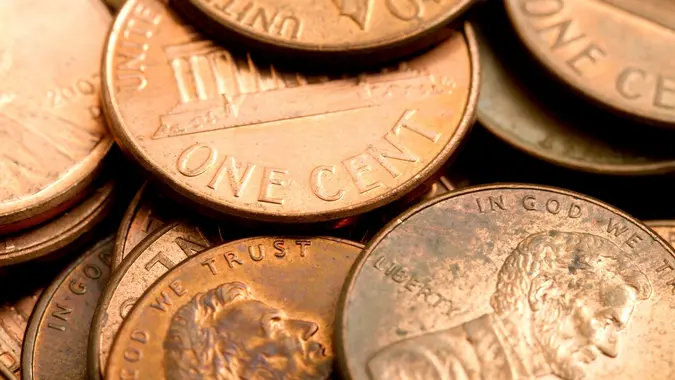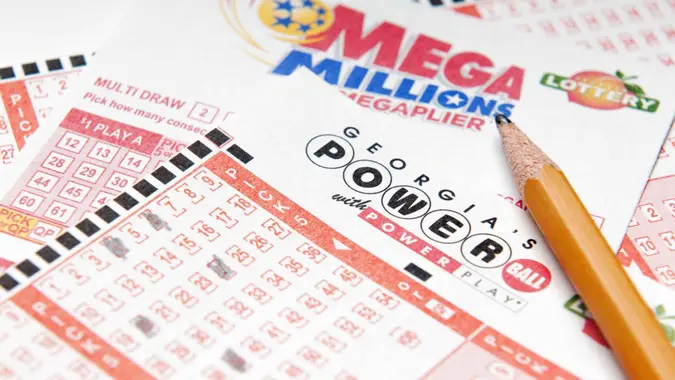What Is a Sinking Fund? How to Stay Prepared for All Expenses

Commitment to Our Readers
GOBankingRates' editorial team is committed to bringing you unbiased reviews and information. We use data-driven methodologies to evaluate financial products and services - our reviews and ratings are not influenced by advertisers. You can read more about our editorial guidelines and our products and services review methodology.

20 Years
Helping You Live Richer

Reviewed
by Experts

Trusted by
Millions of Readers
A sinking fund is money you set aside for a specific goal, like a down payment on a car or a house. That money might also be used to cover other big-ticket items like self-employment tax or a wedding.
But why is it called a sinking fund? Simply put, it’s because you’re gradually saving money over time — or “sinking” money — until you have enough for what you need. With a sinking fund, you don’t have to come up with a huge chunk of cash all at once because you’ve already spent months or even years saving up.
Examples of Expenses You Can Use Your Sinking Fund For
Sinking funds are usually geared toward one specific goal. That can be a short-term, medium-term or long-term goal. It all depends on what you’re prioritizing.
Here are some examples of expenses you can use a sinking fund for:
- Anticipated car repairs or maintenance
- Holiday or birthday gifts
- Wedding reception or other expenses
- Cruise
- Family trip or other vacation
- Home renovations
- Anticipated veterinary bills or pet care
- New home appliances
- Down payment for a car
- Down payment for a house
The main point behind a sinking fund is to have extra money saved for these financial goals so you don’t have to take on more debt or dip into your emergency savings.
You can also start a sinking fund for a specific goal and change it later based on your future priorities or needs. Say you’ve started a sinking fund on a house. If you decide not to buy, you could reallocate that money for something else.
But what if you have multiple things you want to save up for? You can set up a sinking fund for each one. For example:
- $20,000 for a down payment on a house
- $5,000 for a down payment on a car
- $4,000 on new furniture or appliances (for that new house)
- $7,000 for a family trip
Note: This is what a sinking fund is in personal finance. You might also hear about sinking funds in corporate finance or investing — particularly when it comes to repaying debt or buying back issued bonds prior to their maturity date.
How Is a Sinking Fund Different from Other Ways to Save?
On the surface, a sinking account might seem like just another way to save — and in some ways, it is. But it’s more than that. Here’s how sinking funds differ from other savings options:
Savings Account
A savings account is a catch-all term for where you save money. You can keep your savings in an envelope under your bed, for example. Or you can stash it in a high-yield savings account where it can grow.
You might not have a specific purpose for saving money, but it’s nice to have.
Emergency Fund
An emergency fund is money set aside specifically for, well, emergencies. This includes any unexpected expense that falls beyond your usual budget. It might be a flat tire or a trip to the doctor that wasn’t covered by your insurance.
Experts recommend having three to six months of living expenses set aside in case something comes up that impacts your income — like layoffs at work.
Splurge Fund
You might want to have a separate savings account for splurging. These aren’t specific or planned expenses, so they might not fit into your regular budget or savings.
They can be big or small, but they’re most likely spontaneous — like a romantic getaway or when your favorite band comes into town.
An Additional Money Bucket
Your sinking fund is extra money you have in addition to regular savings, emergencies and the like. It’s for specific goals that might not fit into your regular monthly budget. However, you could have a separate category in your budget for your sinking fund.
Say you want to buy a new car in a year. The average new car costs nearly $50,000, but cheaper options exist.
Say you find one for $25,000 and want to put 10% down. You’ll need $2,500. If you have 12 months, you’ll need to set aside about $208 from your budget each month in a sinking fund for that car.
Pros and Cons of a Sinking Fund
Setting up a sinking fund does have quite a few benefits. For example, they can:
- Help you avoid taking on debt (like high-interest credit cards)
- Earn interest if you keep the funds in a HYSA or other interest-bearing account
- Keep you motivated and on track with your goals
- Be created for several different savings goals or only one — whichever you need
A few drawbacks to consider include:
- You’ll have less money available for other things
- You might have to pull from the sinking fund if an emergency arises or your budget falls short
- You’ll need to be disciplined so you don’t dip into the sinking fund before it’s time to use it
Where Should You Keep Your Sinking Funds?
Your sinking funds should be somewhat accessible, so you probably don’t want them to go into a regular investment account. But you also shouldn’t keep them where you’ll accidentally use them. That means no checking accounts either.
Here are some of the best places to keep your sinking funds (depending on your goals):
- High-yield savings account: A high-yield savings account, or HYSA, is similar to a traditional savings account. The main difference is the yields are higher, meaning your money could theoretically grow faster. APYs on these accounts can be 4.00% or higher.
- Money market account: A money market account takes features from checking and savings accounts and combines them into one. These accounts usually offer higher interest rates than checking accounts. They may have higher fees or minimum opening or account balance requirements.
- Certificate of deposit: Certificates of deposit (CDs) are a type of interest-bearing account where you keep your money for a specific amount of time — usually six months or longer. During this time, the account funds will earn interest. If you have medium- or long-term goals, you could put your sinking fund in a CD.
Are Sinking Funds Right for You?
Sinking funds could be a good idea if you have room in your budget to set aside extra cash for specific goals. You’ll generally want to have a separate emergency fund to cover any unexpected expenses, too. That way, you won’t end up drawing from your sinking fund — and taking away from other priorities.
If you’ve never created a sinking fund before, try starting with just one to see if it works with your budget. If it doesn’t, there may be other strategies or savings methods that work better for you.
- What is a sinking fund in simple terms?
- In personal finance, a sinking fund is simply a separate fund used to save for a specific purchase. This could be a vacation or a down payment for a house. It's up to you.
- Are sinking funds a good idea?
- Sinking funds can be a great way to save for short-, medium- or long-term purchases. But whether they're a good idea depends on your budget and goals. If you don't have an emergency fund yet, take the time to create one first. If you have high-interest credit card debt, you may want to pay that off, too.
- What is the difference between a sinking fund and a savings account?
- A sinking fund exists to help you save for a specific expense -- usually within a set period. A savings account is used for general savings or, in some cases, emergencies. You might have a separate sinking fund for each goal, but you might only have one savings account.
- What is the primary purpose of a sinking fund?
- Your sinking fund exists to help you pay a planned expense. You could have a sinking fund on a house. You could have a sinking fund on a car or a vacation. Regardless, you can save up for these potentially big-ticket items over time, so you don't have to stress about money -- or take on debt -- when they come up.
Our in-house research team and on-site financial experts work together to create content that’s accurate, impartial, and up to date. We fact-check every single statistic, quote and fact using trusted primary resources to make sure the information we provide is correct. You can learn more about GOBankingRates’ processes and standards in our editorial policy.
- Investor.gov "Certificates of Deposit (CDs)"
- Kelley Blue Book "Average New Car Price Flirting With Record"
- Washington State Department of Financial Institutions "The Importance of Having an Emergency Savings Account"
- Corporate Financial Institute "Sinking Fund"
 Written by
Written by  Edited by
Edited by 

























